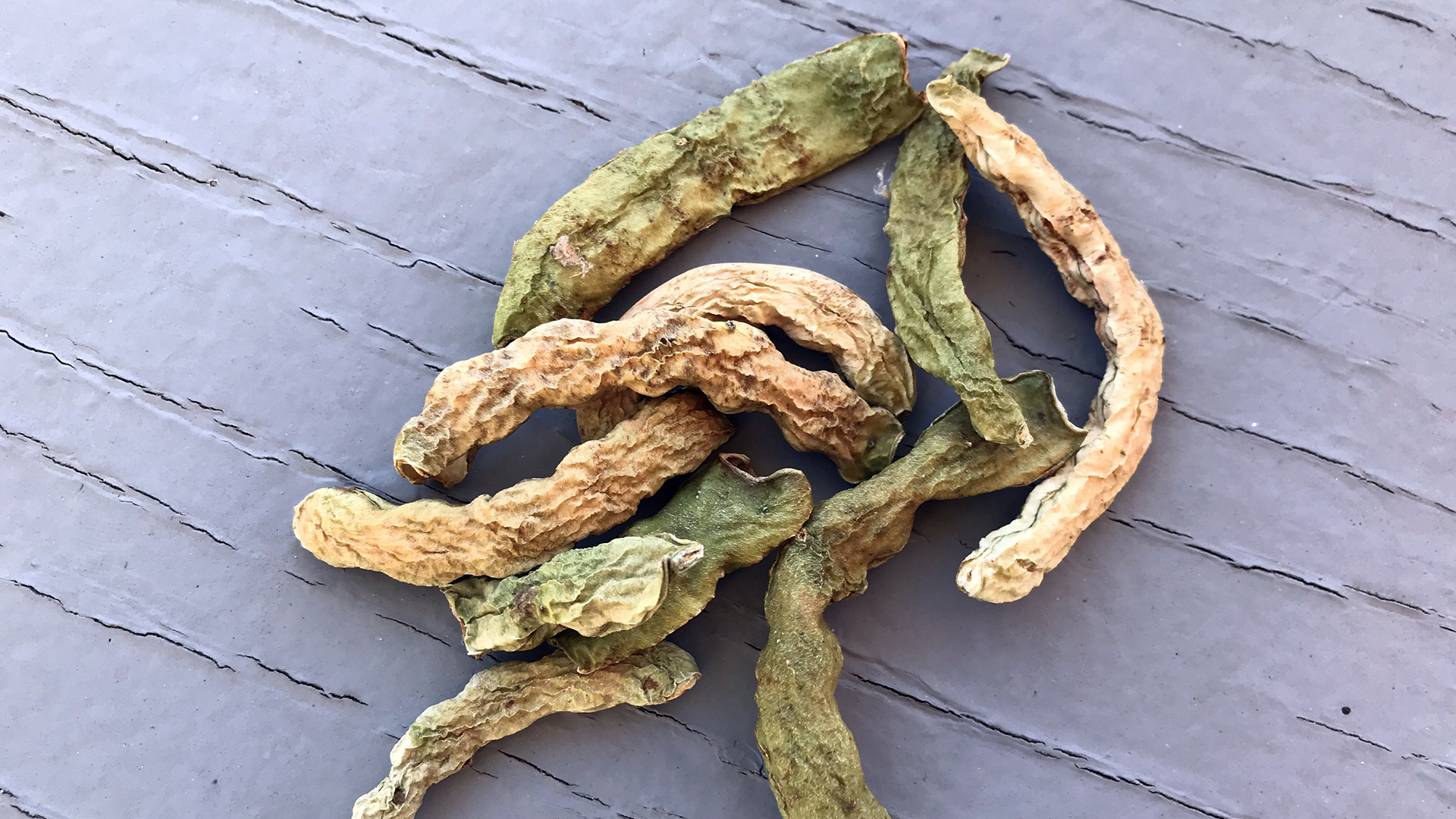
Preservation
Old ways of preserving food run deep in the culture of Appalachia. It turns out that preserving life requires the same principles.
How to make leatherbritches:
- Find a seed saver and convince them to give you dried beans from their last run of greasy cut-shorts.
Note: This green-bean variety rewards growers with big, fat beans—called “greasy” not because you cook them in grease (though maybe that’s just what you want to do), but because the hulls have a glossy sheen. The ends look like they are “cut short” because the large seeds are packed tightly inside the hull. For this task, skinny grocery store beans will not do. Your beans need some heft to them. - Grow your beans.
- Harvest your beans.
- String your beans with needle and thread and hang them to dry, maybe behind the stove or in the barn.
Note: This will be difficult if you have arthritic hands. This will take many hours. - Wait a few months.
- Remove the thread, place the dried beans in a brown paper grocery bag turned down at the top, and give them to your grown daughter for Christmas.
- Wait for her reaction.
Note: Have tissues handy.
How to stay alive:
- Receive prostate cancer diagnosis.
- Ponder what one should do. See many specialists. Research. Discuss.
- Finally concede treatment makes sense, despite being eighty-four years old.
- Drive forty-five minutes each way to receive your radiation treatment.
Note: Allow extra time for construction traffic.
Caution: Pay attention to new traffic patterns. - Repeat thirty-nine times.
- Experience side effects you had hoped would not happen to you.
- Finish treatment.
- Wonder if the side effects will be permanent.
- Cautiously celebrate the disappearance of side effects and good prostate-specific antigen (PSA) reports.
- Ask your daughter if she wants more leatherbritches.
Note: Have tissues handy
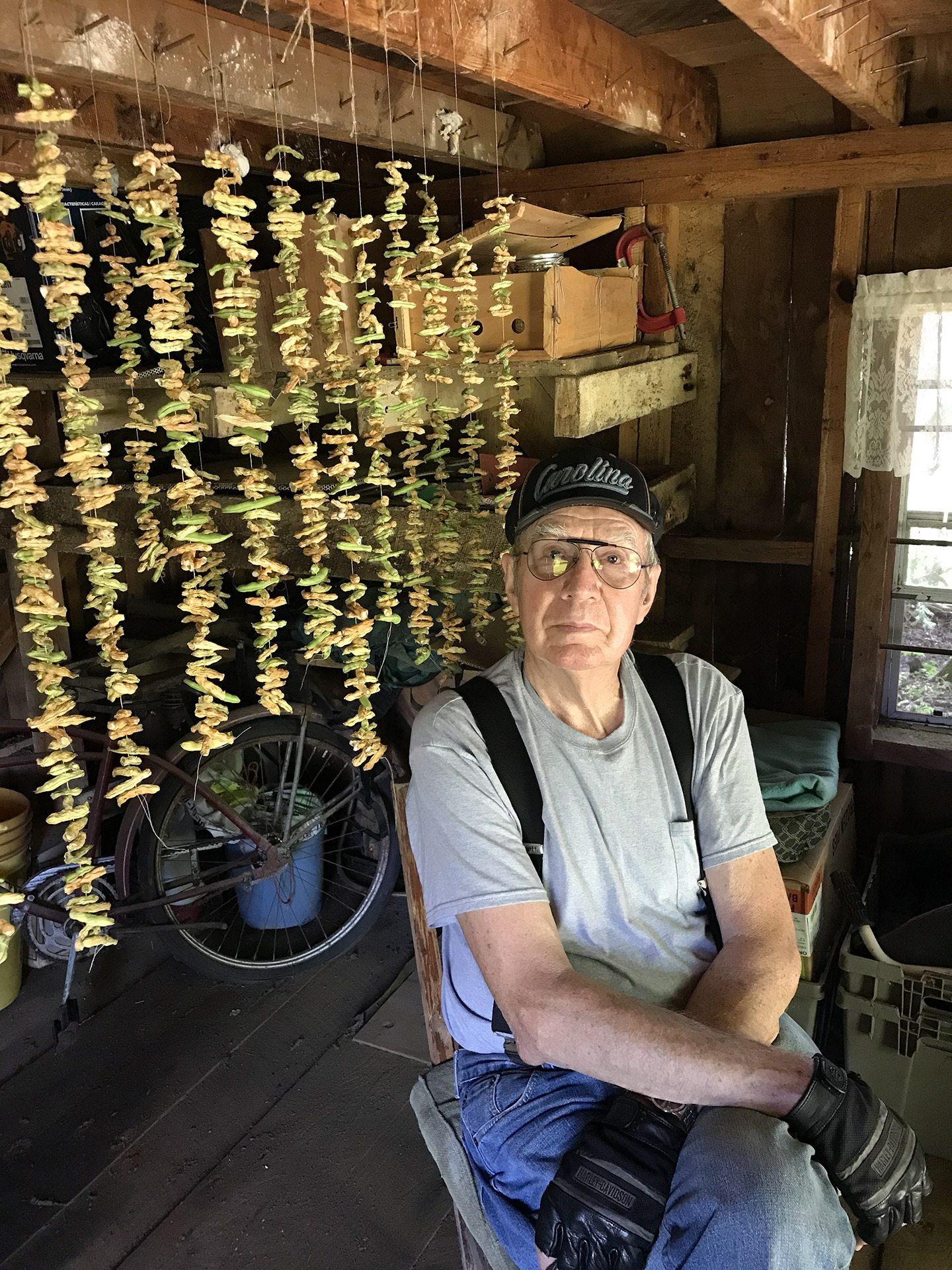
My father was born in 1938 and grew up with his mother and maternal grandparents on a farm in the Big Sandy Mush community of Western North Carolina. If you’re prone to nostalgia and prefer rural life to an urban existence, then his early childhood years were idyllic. His family grew all manner of things, from burley tobacco to a bounty of vegetables to sorghum (what they called sugar cane) used to make sorghum molasses (what they called molasses). They raised and slaughtered hogs. He drank fresh milk, kept cool in a spring house, and they buried cabbages to preserve them through the winter.
They were the self-sustaining family today’s children read about in history books. The daily labor of subsistence farming was not a novelty to them then, as it might seem to us now; no one visited the farm to film their reality as a form of rustic entertainment. Using sorghum to make their own sweetener, using all parts of a hog to provide both main-course protein and seasoning for vegetables and cornbread throughout the year, using spring water to keep milk cool because it was the next best thing to refrigeration, and burying cabbages to keep them from freezing were survival methods that made the most of the abundance their land provided.
Dad grew up with the “old ways” not because they were quaint or thought to be healthier, but because they were the ways to live on a mountain farm.
They preserved food to preserve themselves. It seems almost impossible that my dad’s father figure, his grandfather, was born during Reconstruction, in 1876. Dad grew up with the “old ways” not because they were quaint or thought to be healthier, but because they were the ways to live on a mountain farm.
They also made dried green beans called leatherbritches, presumably because, once dried, the bean hulls look like little leather pants. People in other parts of Appalachia sometimes call them shuck or shucky beans. The opening to James Still’s iconic 1940 novel, River of Earth, for example, references “strings of shucky beans dried in the fall.” Having a supply of dried, protein-rich beans to supplement the table during cold months made good sense.
Historically speaking, dried foods like apples and beans were important staples in the mountain larder. Before the ability to can food was widespread, drying beans was an essential preservation method, and even after women began canning, drying food required far less equipment. Both canning and drying are extremely labor-intensive processes, but using a needle to thread each bean so it may be hung to dry demands good eyesight, a steady hand, and as they say, the patience of Job. My father’s mother and grandmother handled the food preparation, and I have wondered when or how they found the time to grow, harvest, and then thread individual beans with everything else they had to do. They also worked on the farm, helped raise tobacco, and my grandmother worked outside of the home as a schoolteacher. They must have threaded beans at night when other chores were done; I imagine that time was their version of what’s now known as the “second shift,” a term used to describe the unpaid domestic labor women do at the end of a paid workday.
My father’s family worked hard and were smart about how they raised and preserved food. They were also economically prosperous. They owned a Delco generator that powered the house before electricity reached the valley. Since his mother graduated from the Cullowhee Normal School and was a schoolteacher, in the early 1920s she also taught in the community’s adult literacy program. Established by Kentuckian Cora Wilson Stewart in the early 1900s, these were called Moonlight Schools because adults who worked all day had to learn by the light of the moon. As a young child, he had nice things, including a toy wagon, his own rocking chair, and good shoes.
I have a black-and-white photograph of him when he is about five years old, sitting astride his favorite horse, Bonnie. He has on a felt hat, cocked at a jaunty angle. His beloved dog, Ring, rests on the front steps in the background. The look on Daddy’s face is sure, proud, and happy. As a kid growing up in the 1980s, I thought his childhood sounded like a fairytale. Riding in a wagon with his grandfather, going on springtime camping excursions in search of ramps—pungent wild alliums that were often the first fresh vegetables of the season—and keeping a pet skunk for his 4-H project all sounded like a dream to me, a kid who hated dresses, watched too much television, and ate a lot of Little Debbie cakes.
Turns out prosperity mattered little when death came calling. His grandfather died when he was thirteen, his mother died when he was fourteen, and his grandmother died when he was eighteen. The first time he remembers meeting his father, he was fifteen or sixteen; he isn’t sure. His last year of high school, he lived alone in the farmhouse, relying on neighbors for the occasional home-cooked meal.
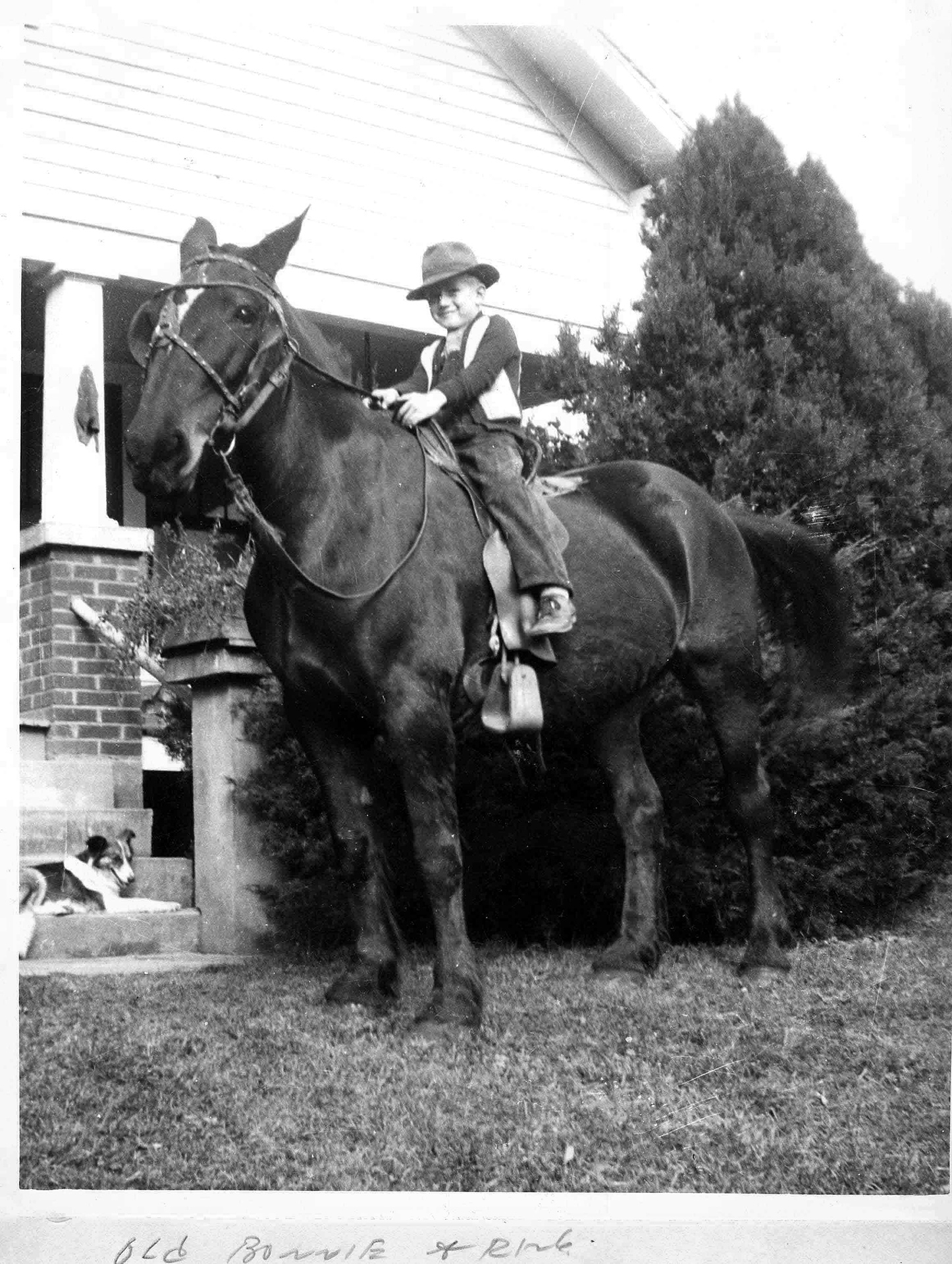
No one was left to make leatherbritches. Those earlier years of emotional and physical plenty had vanished.
You would think such a difficult adolescence would’ve hardened him against life, but the opposite happened. Through the grief and emotional pain he must have felt, he somehow grew to be kind, loving, and generous. His love of the land and of growing things stayed with him. At least once a week during my childhood he would say, “Mon, I’m going to The Mush.” My nickname (short for “monster”) is a subject for another essay, but I cherished those trips to The Mush as much as he did. It only took us about twenty minutes to get there, but we were transported. He could take a break from his plant superintendent job in Arden, one that required him to wake up at 4:30 a.m. every weekday (and some weekends) to stand on a concrete floor until quitting time. I could ramble through brush and bramble, look for salamanders in the creek, and get dirty in a deeply satisfying way that just wasn’t possible anywhere else. He might repair a fence; battle the ever-present multiflora roses, an invasive species that will choke the life out of a farm; or go on a walk. Our people did not “hike.” We walked.
Sometimes we would stop at the Big Sandy Mush Methodist church, where five generations of his family are buried: he will be the sixth, and I will be the seventh generation to rest there. We each have specific wishes about our departures. He wants one red rose on his casket and nothing more because the smell of burning flowers after his mother’s funeral haunts him. She was a beloved member of the community and died too young, so community members turned out in droves for her service, all bearing flowers to honor her memory. My then fourteen-year-old father had to dispose of those flowers; I imagine there was no one else to do it. He hauled them to the creek in a wagon and set them on fire. As for me, I don’t care much about flowers one way or the other, but somebody better sing “I’ll Fly Away.”
During my growing-up years we attended that church, and I can still hear Myrtle Duckett’s warbly voice singing “Leaning on the Everlasting Arms.” She drew out “leaning” for the longest time, and I remember looking out the window at rows and rows of burley tobacco.
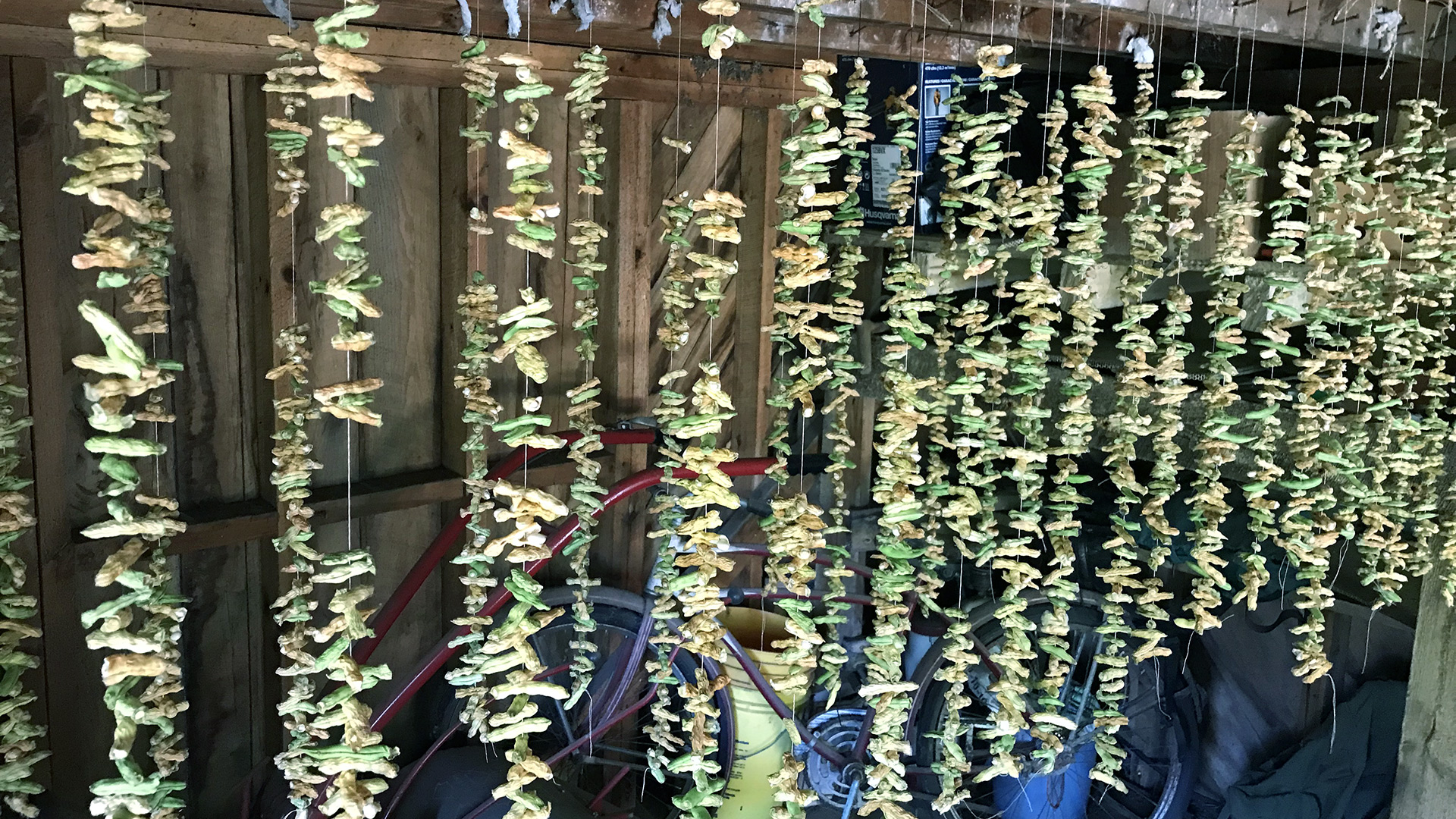
The first Sunday of every September, we went to the church’s Homecoming. Following the requisite church service, we gathered for a community meal in the old schoolhouse next door. I remember marveling that my dad went to school in that big two-story brick building, and I always wanted him to show me different classrooms. Those tours usually triggered a memory and subsequent story, a good way to kill time as we waited for folks to carry in their covered dishes. As church members set up long, brown tables to hold the food, I listened as he told me about a trip to Bear Waller to dig ramps and a late spring snowstorm that caught him on the way home. Back then, ramps were considered low-class, foraged food, but now ramps are trendy foodie food, selling for over $20 a pound at Whole Foods. If I concentrate, I can still taste Mabel Duckett’s ham biscuits, Ann Ball’s black-walnut cake with caramel icing, and Beth Shook’s sweet potatoes. Two of those women are buried in the cemetery now, and the schoolhouse is a thriving community center that offers high-speed internet, yoga classes, and book club meetings. In the last few decades, a lot of new people have moved into the valley, and it is changing. I wonder if they know about greasy cut-shorts or how to make leatherbritches. I wonder if they know where to find a ramp patch or when to set tobacco plants in the springtime.
Daddy wedged in those Sandy Mush visits despite demanding work weeks, and as I got older and more involved in my own activities, he typically went to The Mush alone. Yet he was always finding ways to bring it back to us, often via food. I have a collection of disparate memories that create an unreliable timeline, but the vividness of those tastes and moments is immediate and real.
There was the time he stored fresh ramps in the upstairs fridge and infused seemingly every item in the refrigerator with their strong, pungent scent. I learned that ramp-flavored milk is not appetizing when paired with Honey Bunches of Oats.
Then there was the time in graduate school when I was home for a visit, and he made a big breakfast with eggs, sausage, toast, and gravy. Later that day he asked, “Mon, how’d you like that sausage?” I knew from his expression that a prank was coming, so I cautiously replied, “I liked it …” Giggling, he confessed, “That sausage was three years old! I canned it!” He cured hams; made sauerkraut; took part in and documented the process of making sorghum molasses; grew and dried his own ramps; and made delicious homemade vegetable beef soup. He was and is interested in preserving the foodways of his childhood, including how to make leatherbritches. But my father preserves so much more. He is a walking local history of Big Sandy Mush and the only person I know who can identify every mountain peak in sight. Sometimes I wonder if hours spent making food “the old way” provides a memory path to happy times, one that takes a detour around the years when, as he puts it, “everybody started dying.”
He was and is interested in preserving the foodways of his childhood, including how to make leatherbritches. But my father preserves so much more. He is a walking local history of Big Sandy Mush and the only person I know who can identify every mountain peak in sight.
I can’t be sure, but I think I was nine or ten years old. It must have been summer because he came home with a mess of greasy cut-short beans. He announced he was going to make leatherbritches. My mother asked why on earth he would go to such trouble when Ingles grocery store had shelves full of perfectly good canned beans. She insisted there were so many other, better ways to spend his time, like cleaning the basement. Undeterred, he put a blue plastic tarp on the driveway and spread the beans across it. I can only assume he decided the needle-and-thread approach was too time-consuming. The beans baked in the sun, aided by the heat from the driveway’s asphalt. I remember inspecting them during the day when he was at work, thinking they were in fair danger of being run over. I cannot recall how long they took to dry, nor where he stored them, but I do remember the day he cooked them.
If one follows Ronni Lundy’s recipe for rehydrating and cooking leatherbritches (see Victuals), or Katie Button’s instructions (see Garden & Gun), they are delicious. They are also delicious if dried over the fire as pork is smoked. Elliott Moss did that when he was chef at Buxton Hall Barbecue in Asheville, North Carolina. But if you are not well-versed in these methods, if the women in your family always cooked them when you were a child, and if your wife is sure they have bugs in them anyway, they might taste a bit underwhelming. Even so, I knew then and now that how they tasted wasn’t the point. In the same way, he demonstrated how to make kilt (“killed”) lettuce—fresh lettuce with hot pork grease poured on top (to “kill” it), garnished with onions and a boiled egg—the transference was more than caloric. As tradition bearers go, an MTV-loving kid was an unlikely candidate, but it seems he knew what he was doing. The impulse to preserve things, whether food, stories, or a way of life, runs deep. He has given me precious material, both tangible and not, to save, document, and share. I worry I am not up to the task, but I am trying.
Fast forward a few decades, through college years, graduate school, and the miracle of a faculty position at the University of North Carolina Asheville, and here I am, deeply invested in the study of this region and its culinary traditions. Through it all, Daddy has continued to express his love for me through food. When I began my job as a professor, I rented an apartment close to campus, and, on more than one occasion, I came home to find fresh vegetables sitting on the front stoop. Sometimes he left tomatoes, sometimes cucumbers, and once, squash. By the start of the pandemic, I was deep in research for my second book, Appalachia on the Table: Representing Mountain Food and People. As the virus raged and we waited for vaccines, our weekly visits became outdoor affairs on the porch, rain or shine. On Christmas day in 2020, my daughter and I pulled up to Mom and Dad’s house to see them waiting for us outside. After we exchanged presents, Daddy gave me a brown paper grocery bag and said, “Merry Christmas, Mon.” Inside were cups and cups of leatherbritches.
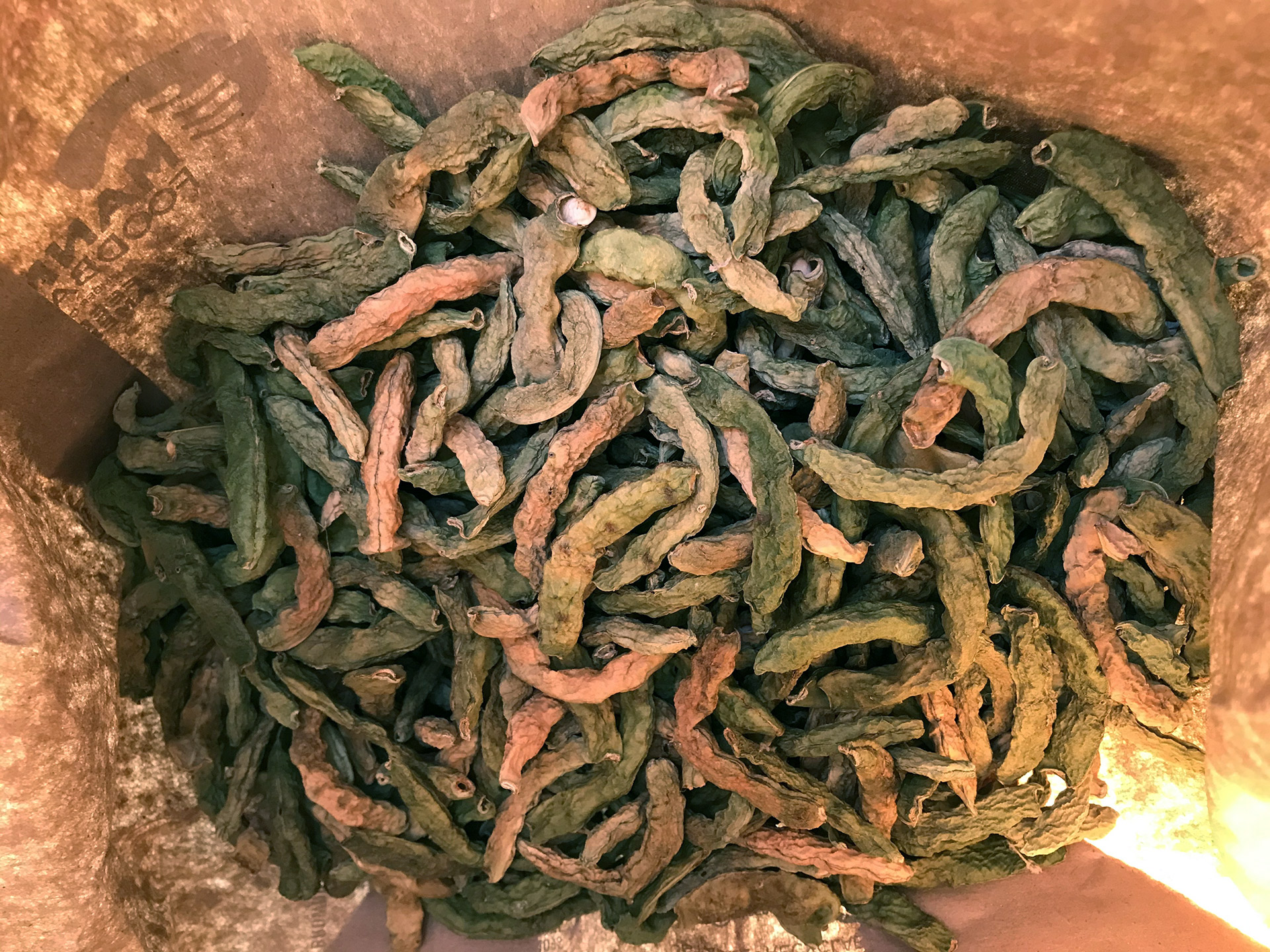
I am forty-five years old, and those dried beans were and are the best, most meaningful gift I have ever received. I thought about the button helper I ordered for him, so his stiff, arthritic hands wouldn’t stop him from buttoning his shirts. I thought about how he doesn’t have feeling in all his fingers. I felt a lump swelling in my throat as I marveled that he threaded those beans. The next year, he did it again, but on an even larger scale so I could “send some to all those people who are helping you with your book.” And I did.
Meanwhile, Dad’s prostate-specific antigen (PSA) numbers were rising. His primary care physician, whom he trusts and has known a long time, kept recommending a “wait and see” approach, especially given Dad’s advanced age. I am not a “wait and see” kind of person, but I tried to keep my opinions to myself. Finally, once his PSA reading was well over double the normal range, we saw a urologist. Testing revealed a malignant growth that, given its location, looked likely to spread, but it hadn’t yet. We learned about why surgery was not recommended for someone in his mid-eighties, about hormone therapy and accompanying side effects, and about many kinds of radiation. We listened to anti-treatment rationales that reasoned treatment would do more damage than good for someone his age.
Not a day passes when I don’t think about The Mush. I dream of living there in the summer, and I toy with the notion of living there year-round, though I know it isn’t feasible. I also think about what I will preserve, what I will pass on.
Would treatment fill his remaining years with undesirable side effects, or would it save his life and leave him with time worth having? Ever the optimist, Dad opted for treatment. I cried tears of relief. He has always been mentally and physically strong, but to get through this, I think he drew from strength even he didn’t know he had. Now, two years after we began seeing specialists, he is back to normal, and his PSA reading is almost non-existent. That could change, but for now, life has been preserved.
Not a day passes when I don’t think about The Mush. I dream of living there in the summer, and I toy with the notion of living there year-round, though I know it isn’t feasible. As someone with a demanding job and a young daughter, adding a long, rural commute makes no sense. I know this. Yet still, I consider it.
I also think about what I will preserve, what I will pass on. When I made that first batch of leatherbritches (with smoked ham hock and lots of garlic) on New Year’s Eve, my typically picky daughter tried them and said they were “pretty good.” She also remembers the pre-pandemic community dances we attended at the Big Sandy Mush Community Center. For her, “Sandy Mush” and bluegrass are synonymous terms of endearment.
Later that year, in June, I cooked up another pot to celebrate Mom and Dad’s fifty-sixth anniversary. Even my mom, someone who generally views food as an unfortunate requirement for survival, said they were delicious. The next year, when Daddy gave me more, I was meticulous in how I saved them. With his approval, I stored them in our unheated sunroom instead of our questionably damp basement. Later, when I opened the paper bag to make a long-awaited pot, moths flew out. Reluctant to cook them, even after multiple rinses, I finally threw them away. I cried for the wasted hours he spent threading them, I cried for the loss of delicious food, and I cried for the persistence of time. Nothing lasts forever, but we preserve what we can.
About the author
Erica Abrams Locklear is a professor of English and the Thomas Howerton Distinguished Professor of Humanities at the University of North Carolina Asheville. She is the author of Appalachia on the Table: Representing Mountain Food and People(University of Georgia Press) and Negotiating a Perilous Empowerment: Appalachian Women’s Literacies (Ohio University Press). She is a seventh-generation western North Carolinian who loves good food and good books.


I remain nostalgic, would like to meet your Dad and I know too well when to set out tobacco. Wonderful read!
Hi Erica, I look forward to your conversation with Chuck tonight. I share your love of the connections among food, family, and place. While you write of those connections in the mountains, I write of them at the seashore.
Best regards,
Deb Bowen